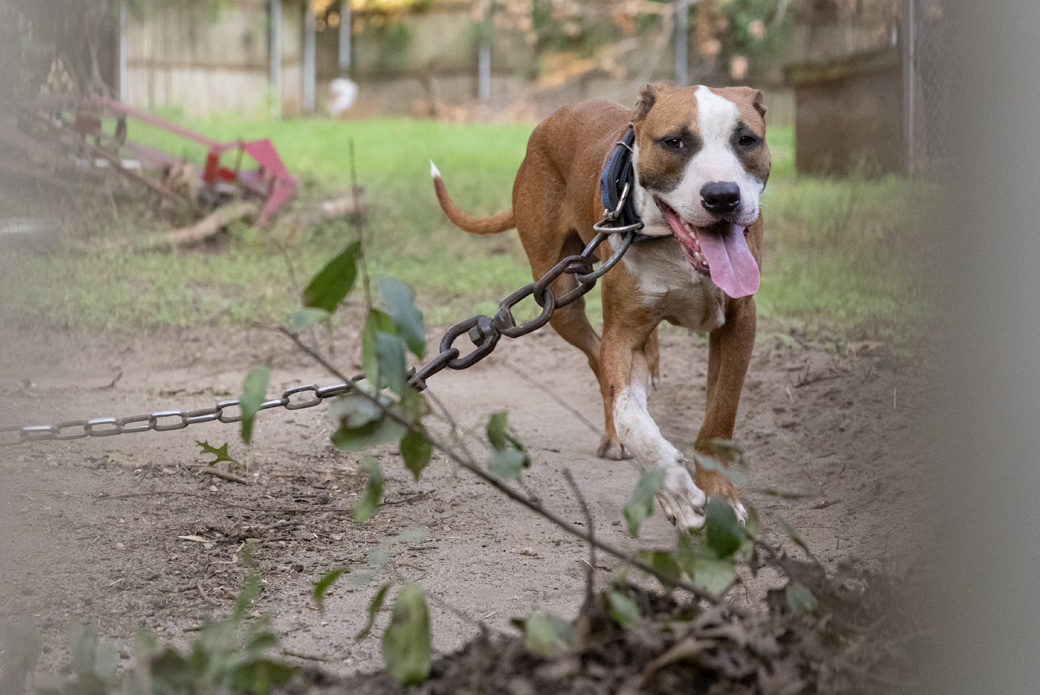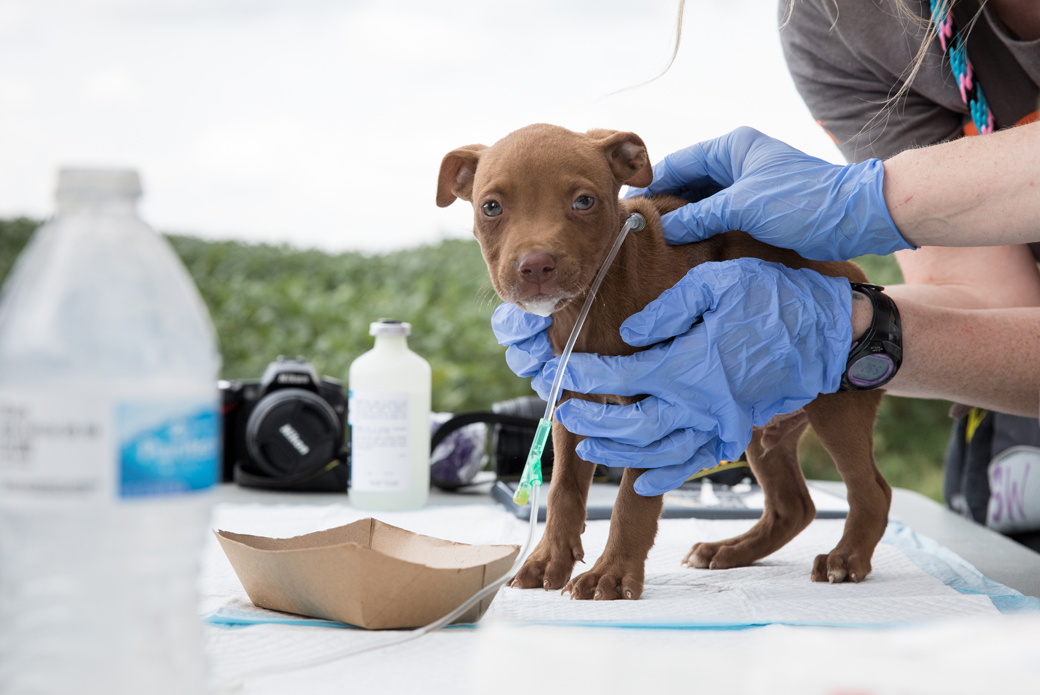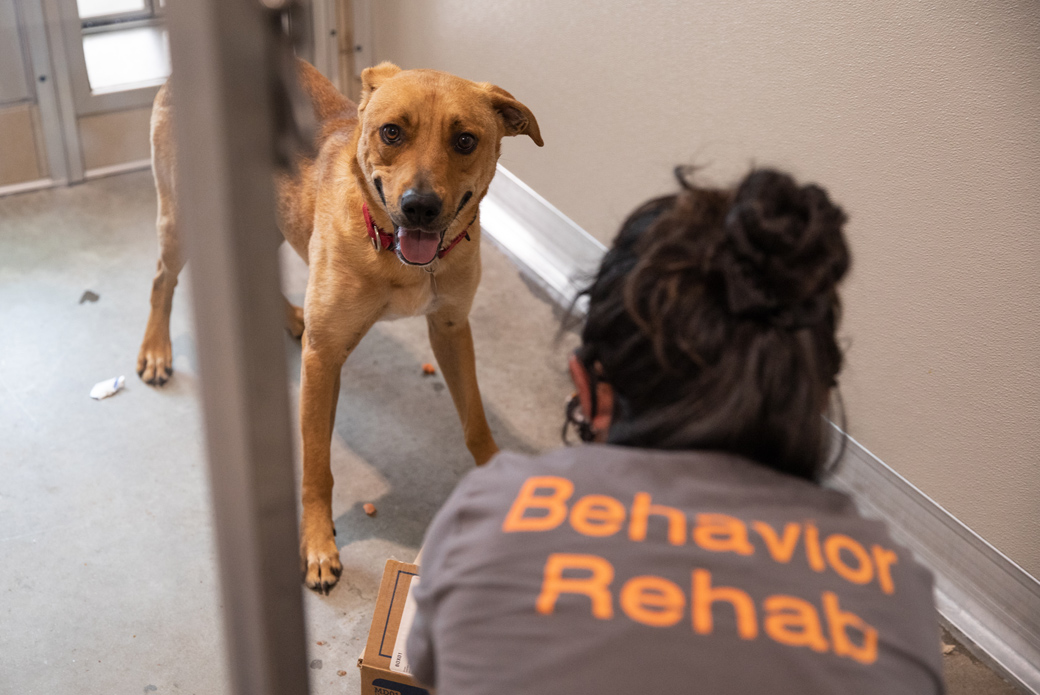
Behind the Scenes of an Animal Rescue

The ASPCA frequently participates in animal rescue operations, both large and small, all over the United States. Here’s an inside look at what goes into planning and executing a lifesaving rescue.
- Investigation and Legal Support
- Operational Planning and Setup
- Animal Removal and Forensics
- Intake and Medical Treatment
- Forensic Behavior Evaluations and Behavioral Rehabilitation
- Placement
-
Impact
 Investigation and Legal Support
Investigation and Legal Support

Many of our cases begin at the investigation stage, with law enforcement, prosecutors, or animal welfare agencies from across the country contacting the ASPCA for assistance with animal cruelty cases. They might get in touch at the very beginning of an investigation—when they’re not yet certain if the situation rises to the level of a criminal offense—or later in the process once they’ve concluded that a rescue operation is necessary. Other times, the work of our own investigators, whether following up on tips from concerned citizens, or through proactive investigations, can uncover situations where there is evidence of animal cruelty and reaching out to law enforcement is the appropriate step. Either way, the ASPCA’s vast investigative, forensic, legal, behavioral, operational and sheltering expertise can play a critical role in supporting local law enforcement, with teams often traveling to provide assistance.
Requests for the ASPCA’s assistance are sometimes quite time-sensitive because law enforcement is facing a dire situation in which the animal victims are in crisis and intervention must be immediate. The ASPCA is unmatched in our ability to help animals quickly while supporting the criminal investigation, maintaining the integrity of a crime scene, documenting the conditions of the animals, and providing subject-matter expertise to help authorities build a criminal case and lay the groundwork for a successful prosecution.
If a case progresses to a prosecution, the ASPCA’s Legal Advocacy and Investigations department provides expert assistance to law enforcement and prosecutors, providing legal support and the coordination of other expert services.
 Operational Planning and Setup
Operational Planning and Setup

For certain cases, an emergency temporary shelter is needed to serve as a home for the rescued animals during the oftentimes protracted period before the court determines ownership. It can be challenging for our staff to identify an appropriate location for a temporary shelter, and the pressure is even greater when a seizure is imminent and a location has to be secured quickly.
Every situation is different and presents unique complexities. On top of the more obvious baseline requirements for a temporary shelter—like electricity, running water and proper ventilation—a mountain of practical details must be ironed out before any location can be utilized. These details can include zoning considerations, obtaining the proper permits, complying with veterinary practice laws, and security.
In circumstances where temporary shelters are not needed, rescued animal victims are transported to the ASPCA Cruelty Recovery Center (CRC)—a permanent facility where cruelty victims will receive the shelter and care they need from ASPCA staff as their legal case continues.
Every case is a distinct logistical puzzle and requires a diverse array of supplies, vehicles and responders. Once we have a plan in place, the team springs into action to prepare the unique sheltering requirements. In addition to preparing supplies for the animals—food, transport crates, pens, cleaning supplies, medical supplies, enrichment supplies and equipment—we must get our responders there, and longer stays require rotating in a new group of skilled professionals weekly.
Here’s an example of what one of our emergency shelter set-ups might look like:

 Animal Removal and Forensics
Animal Removal and Forensics

Once law enforcement has the authority to execute a search warrant, the ASPCA response team holds a meeting the day before with any other participating agencies (such as law enforcement or staff from other animal welfare organizations) to review the exact plan and finalize roles, responsibilities and protocols. The ASPCA provides particular expertise with respect to the special challenges in processing crime scenes involving animals and closely collaborates with law enforcement, whether local, state or federal.
Following strict protocols is critical. Once we arrive on the property, we immediately conduct a full inventory of the animals, taking care to document any scars, injuries or signs of disease, as well as document environmental factors like overcrowding, unsanitary living conditions or other circumstances that cause the animals to suffer psychologically.

Investigators and forensic analysts walk through the property and take notes, photos and videos, as well as draw a detailed crime scene sketch. The teams document evidence like blood spatter, gravesites and paraphernalia associated with the crime. This is all evidence that will aid prosecutors with any future criminal proceedings.
Our mobile Animal Crime Scene Investigation and Medical Animal Surgical Hospital (MASH) units are often on the scene to help with evidence collection, forensic work and veterinary triage. The MASH unit is a custom-built, mobile animal hospital that allows veterinarians to provide critical care to animals onsite. The vehicle includes a surgical suite, exam tables and diagnostic technology allowing for immediate medical results.
 Intake and Medical Treatment
Intake and Medical Treatment

Each animal is assigned a unique alpha-numeric code and given a collar or tag bearing that identifier. As soon as possible, we bring the animals to the temporary emergency shelter or CRC using our state-of-the-art Animal Transport Trailers. Our team is capable of moving hundreds of animals in a day.
At the shelter, the animals are greeted by a medical team, animal handlers, behavior experts and daily care staff, and go through intake. After the intake process, they are triaged by veterinarians, who examine them, administer any necessary emergency treatment, take notes on their overall condition and lay out a treatment plan. The animals are then set up safely in their enclosures to settle in and rest before any additional treatment.

In addition, the animals’ improvement in health is documented as evidence. Depending on the progression of the case, the animals may stay in our care, many receiving ongoing medical treatment for anywhere from a few weeks to more than a year.
 Forensic Behavior Evaluations & Behavioral Rehabilitation
Forensic Behavior Evaluations & Behavioral Rehabilitation

During their time in our care, the animals receive expert professional, ongoing behavioral assessment, enrichment and treatment.
Once settled in, animals undergo a forensic examination which includes a thorough physical examination, photographic documentation and diagnostics, such as blood work.
After animals have had a few days to acclimate to the CRC or one of our temporary shelters, our Behavioral Sciences Team (BST) performs forensic behavior evaluations. The primary purpose of the evaluations is to document the behavioral condition of the animals to support future criminal proceedings. Cruelty victims are more likely to suffer from debilitating behavioral conditions, including severe fear and aggression, than animals who have not been subjected to abuse and neglect. Detailing the behavioral damage suffered by these animals can further bolster charges of cruelty. Once behavior challenges have been identified, the CRC staff provide the expertise, time and space for animals to heal and recover during the pendency of criminal cases. CRC behavior experts treat a range of behavior problems, including providing specialized behavior modification for extremely fearful dogs who ultimately may need to go to the Behavioral Rehabilitation Center (BRC) for more intensive help. The CRC staff works to ensure that all the animals in our care enjoy a good quality of life and receive the medical and behavioral treatment that they need to ultimately succeed in adoptive homes.
 Placement
Placement

If and when the ASPCA gains ownership of rescued animals, we collaborate with our extensive network of shelter partners and rescues to find them new homes. Our partners are critical to ensuring animals from cruelty cases have the best chance at finding an adopter who can provide them with the life they deserve after their rescue. In addition, we sometimes host local adoption events to help find loving homes for rescued animals. ASPCA staffers from throughout the organization, as well as many of our dedicated volunteers, often travel far from home to pitch in for these unique transports to partners and special adoption days.
 Impact
Impact

When all is said and done—when the animals are safe and healed, and we’ve packed up our gear and headed to the next case—an important part of our work is what we leave behind in the form of education and awareness. The ASPCA strives to pass on our knowledge and experience to our law enforcement partners: We work with them to identify effective means to investigate animal-related crimes, because these techniques are often different from those employed for human-on-human crimes. This collaboration leaves law enforcement units that may not have much experience with animal cases better equipped to respond to similar situations in the future.
